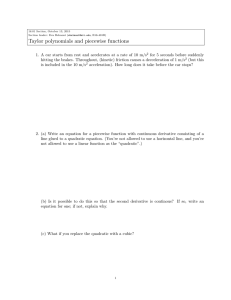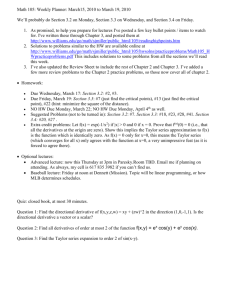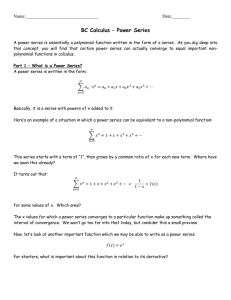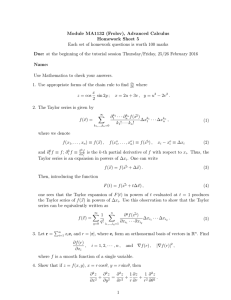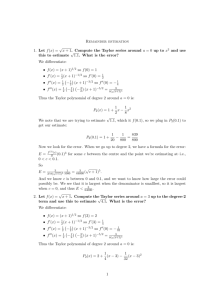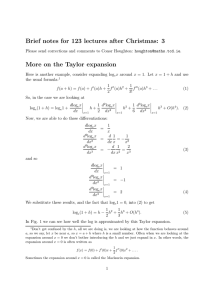Brief notes for 123 lectures after Christmas Introducing the Taylor expansion
advertisement
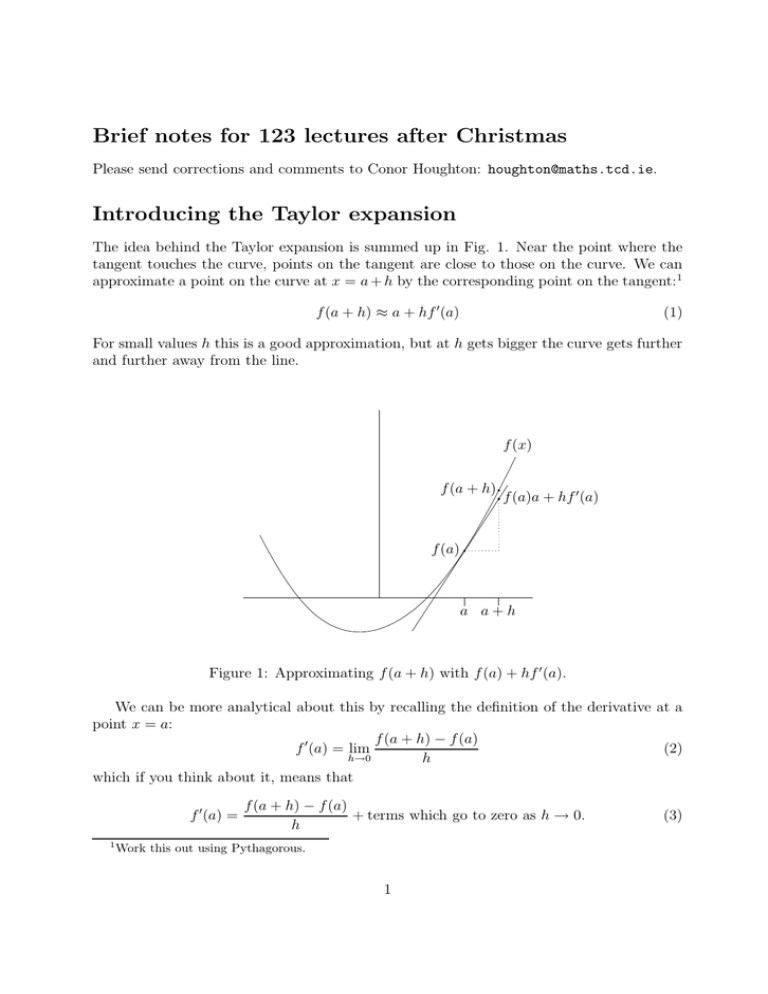
Brief notes for 123 lectures after Christmas Please send corrections and comments to Conor Houghton: houghton@maths.tcd.ie. Introducing the Taylor expansion The idea behind the Taylor expansion is summed up in Fig. 1. Near the point where the tangent touches the curve, points on the tangent are close to those on the curve. We can approximate a point on the curve at x = a + h by the corresponding point on the tangent:1 f (a + h) ≈ a + hf 0 (a) (1) For small values h this is a good approximation, but at h gets bigger the curve gets further and further away from the line. f (x) f (a + h) f (a)a + hf (a) 0 f (a) a a+h Figure 1: Approximating f (a + h) with f (a) + hf 0 (a). We can be more analytical about this by recalling the definition of the derivative at a point x = a: f (a + h) − f (a) (2) f 0 (a) = lim h→0 h which if you think about it, means that f 0 (a) = 1 f (a + h) − f (a) + terms which go to zero as h → 0. h Work this out using Pythagorous. 1 (3) Now terms which go to zero as h goes to zero must be of the form h×something. The notation for terms of the form h×something is O(h). In the same way, we write O(h2 ) for terms of the form h2 ×something and, more generally we write O(hn ) for terms of the form hn ×something. Continuing with our calculation, we have f (a + h) − f (a) + O(h). h (4) hf 0 (a) = f (a + h) − f (a) + O(h2 ) (5) f (a + h) = f (a) + hf 0 (a) + O(h2 ). (6) f 0 (a) = and so, multiplying across by h or, This show why, for nice functions, f (a) + hf 0 (a) is close to f (a + h) when h is small, this is because h2 is even smaller: if h = .1, h2 = .01 and so on. In fact, we know what the O(h2 ) bit is, by calculations similar to the one above we can work out as many terms as we like to give the Taylor expansion: 1 1 1 f (a + h) = f (a) + hf 0 (a) + h2 f 00 (a) + . . . + hr f (r) (a) + . . . + hn f (n) (a) + O(hn+1 ) (7) 2 r! n! where f (r) (a) means taking the derivative of f (x) r times at a. Some examples might make this clearer, lets consider the exponential ex . By taking the first two terms of the Taylor expansion dex h 0 e =e + h + O(h2 ) = 1 + h + O(h2 ) (8) dx x=0 or by taking the first four terms dex 1 d2 ex 1 d3 ex h 0 2 e = e + h+ h + h3 + O(h4 ) dx x=0 2 dx2 x=0 3! dx3 x=0 1 1 = 1 + h + h2 + h3 + O(h4 ) 2 6 (9) The more terms you take, the higher the order the remainder will have and the more accurate an approximation is made by the Taylor expansion. This is shown by the plots given in Fig. 2. Of course some function have Taylors series that run out, if f (x) = x2 + x + 2 well, the Taylor series around x = 0 is just f (x) again. In the next lecture we’ll look at some more Taylor expansions and we will see how the Taylor expansion agrees with the binomial expansion when they both apply. 2 4 3 2 1 -1.4 -1.2 -1 -0.8 -0.6 -0.4 -0.2 0.2 0.4 0.6 0.8 x 1 1.2 1.4 Figure 2: This show the Taylor series approximation of ex . Reading downwards on the right, the lines are ex , then 1 + x + 21 x2 + 61 x3 and finally 1 + x. 3
